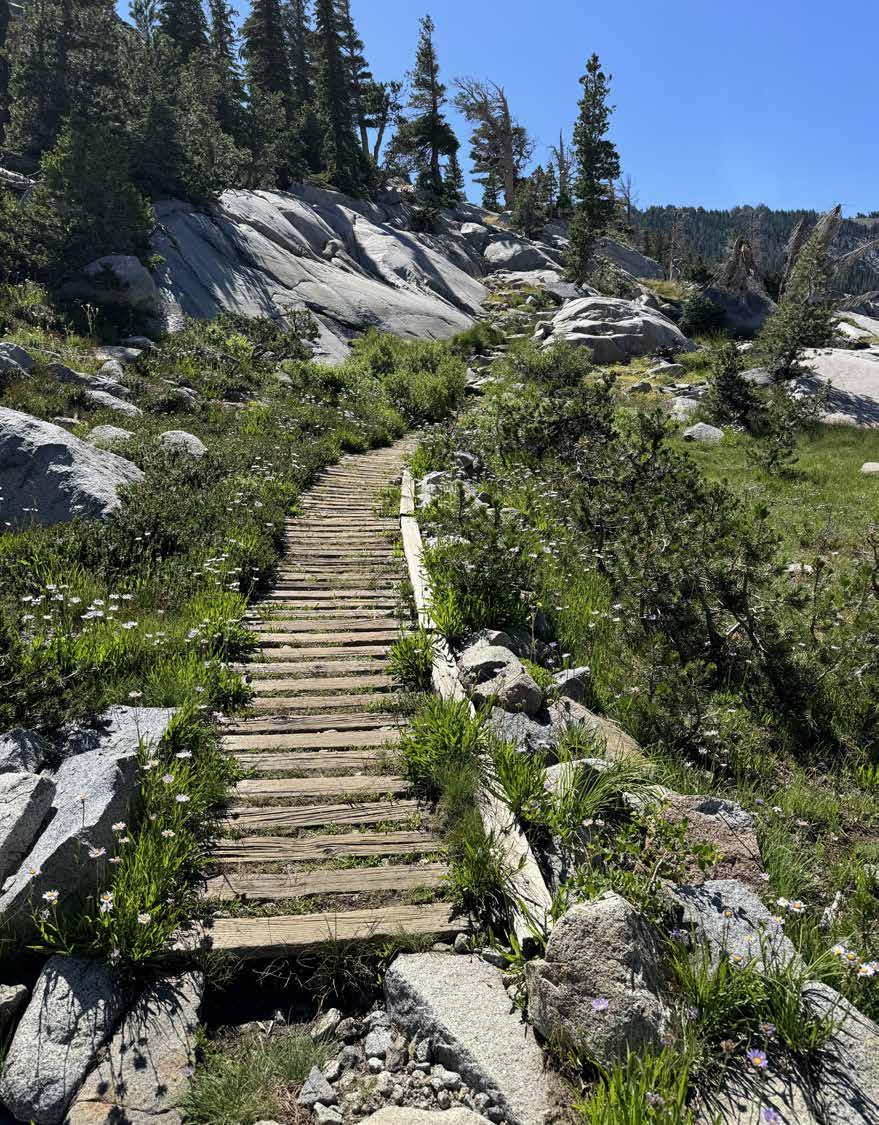
Learn how the TRTA is working to make connections on pages 4 and 8


Learn how the TRTA is working to make connections on pages 4 and 8
The Tahoe Rim Trail Association (TRTA) has long relied on a strong partnership with the U.S. Forest Service (USFS) to maintain the iconic 200-mile trail system that circles Lake Tahoe. While recent changes in federal staffing and funding have introduced uncertainty, the TRTA remains focused on its mission: protecting access, maintaining trail quality, and supporting outdoor recreation across the region.
In a show of resilience and collaboration, TRTA extended job offers to several laid-off USFS field staff, retaining essential trail expertise and helping ensure a smooth transition into the 2025 season.

by Lindsey Schultz Executive Director
Outdoor recreation is more than a pastime in the Tahoe Basin, it’s a cornerstone of the local economy and a vital part of life for residents and visitors alike. Each year, more than a million people experience the beauty of the region by trail, contributing over $90 million through recreation-based tourism. Well-maintained trails also lighten the burden on land managers by reducing infrastructure wear and encouraging responsible use.
While some previously paused federal grant reimbursements have resumed, future funding is still uncertain. Important projects—like the Tahoe Meadows ADA-accessible loop, trail preservation in Desolation Wilderness, and sensitive habitat work in Page Meadows—may still be delayed or disrupted depending on how things unfold.
The Tahoe Rim Trail isn’t going anywhere. Access will remain. What’s really at stake is our ability to be responsive- to repair what needs fixing, protect what’s vulnerable, and continue improving the trail experience for everyone who loves it. That includes providing guided trail experiences that deepen people’s connection with nature- especially our youth. When kids feel a real sense of ownership and wonder out here, that connection lasts a lifetime.
The future of the Tahoe Rim Trail doesn’t depend on one agency or one funding source- it depends on a community that cares.
1. Renew your Membership
Your membership fuels the behind-the-scenes work that mitigates hazards, protects the trail corridor and viewshed, and promotes sustainable recreation no matter what happens at the federal level.
2. Volunteer with Us
Last year, more than 11,000 hours were donated by volunteers like you. From swinging tools to guiding hikes and trailhead education, there’s a place for everyone on the trail team.
3. Speak Up for Trails
If you love the outdoors, let your local representatives know. Trails support healthy communities, thriving ecosystems, and vibrant economies.
We’ve always been a community-powered organization. When people show up, whether with a shovel, a donation, or just their voice, it makes a difference. The Tahoe Rim Trail is resilient, and so are the people who care for it. Get involved at tahoerimtrail.org | Follow us @TahoeRimTrail.
The Trail Blazer is the official publication of the Tahoe Rim Trail Association, a 501(c)3 non-profit whose mission is to maintain and enhance the Tahoe Rim Trail system, practice and inspire stewardship, and preserve access to the natural beauty of the Lake Tahoe Region.
Executive Director
Lindsey Schultz
Deputy Director
Veronica Palmer
Trail Operations Director
Sam Donnelly
Communications Manager
Daniel Corona
Development Manager
Brooke Clayton
Finance & Administration Manager
Judi Van Fleet
Guided Programs Manager
Fiona Pedrick
Trail Operations Manager
Briegan Aguilar
Youth Programs Manager
Michelle Witte
Engagement Coordinator
Colleen Hoffman
President Tricia Tong
Executive Vice President Rishi Batra
Treasurer Larry Stites
Trail Ops Chair Jim Crompton
Trail Use Chair Sharell Katibah
Secretary Rebecca Cremeen
Board Members
Amy Cornelius, Justin Knowles , John McCall, Theresa Papandrea, Faye Provenza, & Robin Soran


The Tahoe Rim Trail Association works in partnership with the USDA Forest Service and Nevada Division of State Parks
With gratitude,

Lindsey Schultz, Executive Director




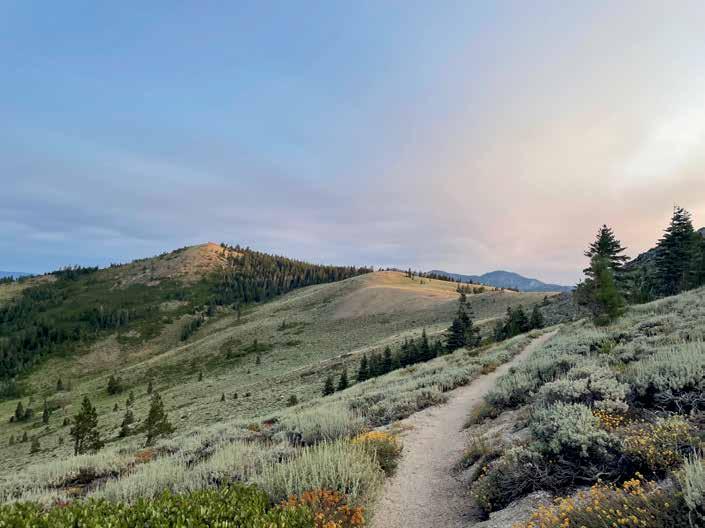


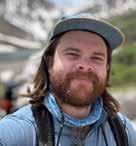
lpine meadows are some of the most stunning and ecologically vital landscapes in the Lake Tahoe area with their lush wildflowers, expansive views, and rich biodiversity. A healthy meadow system with native grass, flowers, and shrubs provides habitat for hundreds of species of animals. But meadows have other important impacts just below the surface. They function as natural sponges, absorbing snowmelt, filtering stormwater runoff, reducing unwanted flooding, and preventing soil erosion. These functions contribute to the constant source of clear water entering Lake Tahoe, long after the rain has stopped and the snow has melted. Healthy meadows also function as carbon sinks, absorbing more carbon than they release. This occurs when plants photosynthesize and pull CO2 from the atmosphere. When the plant dies and decomposes, the carbon can then be stored in the soil for many decades. This process occurring in meadows is invaluable in the face of climate change.
For humans, meadows often provide access to scenic vistas otherwise obscured by the forest. Beyond hiking, biking and equestrian use, meadows are excellent spots for birding, fishing, hunting and countless other activities loved by outdoor enthusiasts. Unfortunately, meadows are fragile ecosystems, and overuse can quickly cause long-term damage. Users can easily compact soil, trample plants, and create deep ruts, which can turn trails into rivers. This disruption can lower
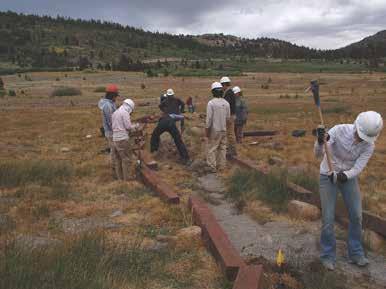
the water table, reducing a meadow’s ability to absorb and hold water, impairing plant health, and diminishing its capacity to store carbon. Over time, unsustainable trails lead to accelerated meadow degradation and less enjoyable hiking conditions—no one likes slogging through muddy, waterlogged trails. By implementing sustainable trail solutions such as boardwalks and reroutes, we can continue to enjoy the beauty and benefits of meadows for years to come.
The Tahoe Rim Trail Association has two meadow trail work projects planned in the coming years: the Page Meadows Trail Restoration and the Tahoe Meadows Interpretive Loop. These projects will enhance user experience, improve accessibility, and protect fragile habitats for generations to come.
Page Meadows, located near Tahoe City, is a beloved destination for trail users in the Tahoe Basin. However, years of heavy use have taken a toll on the area. Several sections of the trail have widened or braided due to users attempting to avoid muddier areas of trail. Numerous social trails—unofficial paths created by visitors—have further fragmented the meadow. Some areas of Page Meadows experience perennial flooding in the spring. While this is an important, natural function of meadows, traveling on a flooded trail causes resource damage and is not the most enjoyable experience for trail users.
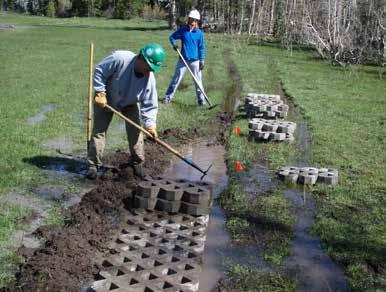
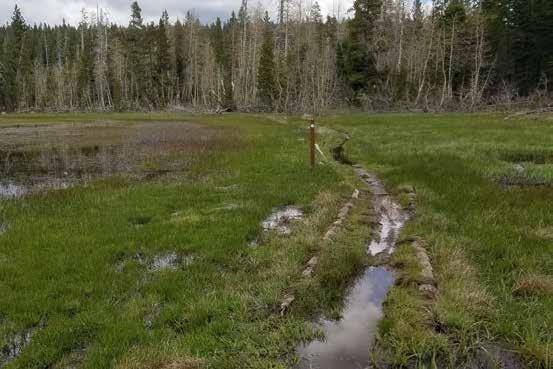
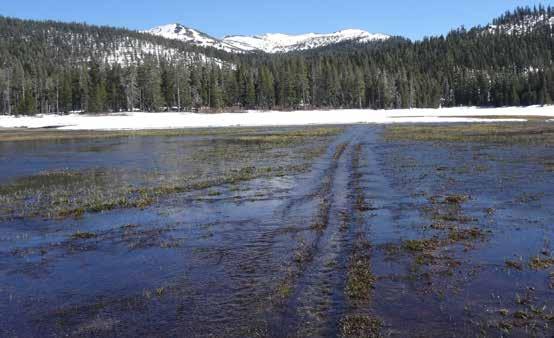
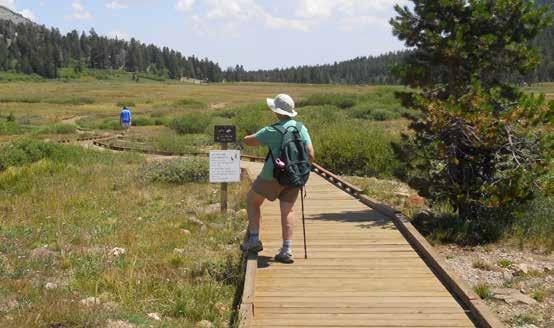
To address these challenges, the TRTA will replace sections of the trail that pass through the meadow with sustainable alternatives that minimize environmental impact. The project will focus on rerouting trails out of sensitive wet areas, consolidating braided paths, and building over 800 feet of puncheon through the meadow. Like a boardwalk, a puncheon lifts the trail above ground level, providing a stable walking surface without trampling sensitive vegetation. These improvements will not only enhance the ecological health of the meadow but also improve the hiking and biking experience. By ensuring a well-designed and durable trail system, TRTA and partners are helping protect this cherished landscape while making it more enjoyable for visitors.
Another exciting TRTA project is the Tahoe Meadows Interpretive Loop. This loop will become the first backcountry trail in the Tahoe region to meet Americans with Disabilities Act (ADA) requirements and will make one of the area’s most scenic meadows more accessible, broadening the opportunity for sustainable recreation.
TRTA will reroute segments of trail out of the meadow, convert old sections of road, build boardwalks, and adjust culverts to improve trail sustainability and waterflow. These improvements are dual purpose—to enhance wetland habitat while creating a sustainable, easy-to-navigate trail. The construction will ensure that wheelchair users, families with strollers, and other individuals have improved access to experience the beauty of Tahoe Meadows and the Lake Tahoe Basin backcountry. As a multi-year project, this initiative represents a major step toward inclusive outdoor recreation and meadow health in the Tahoe region.
Each of these projects will be a lot of work, but the benefits will be substantial. With sustainably built trails, we can conserve the beauty and diversity of these meadows without walking or rolling through the mud. For those looking to help, work like this only happens with volunteer support. If you are interested, please go to tahoerimtrail.org/ volunteer-trail-workdays/ where you can sign up for trail updates or sign up for a volunteer workday!

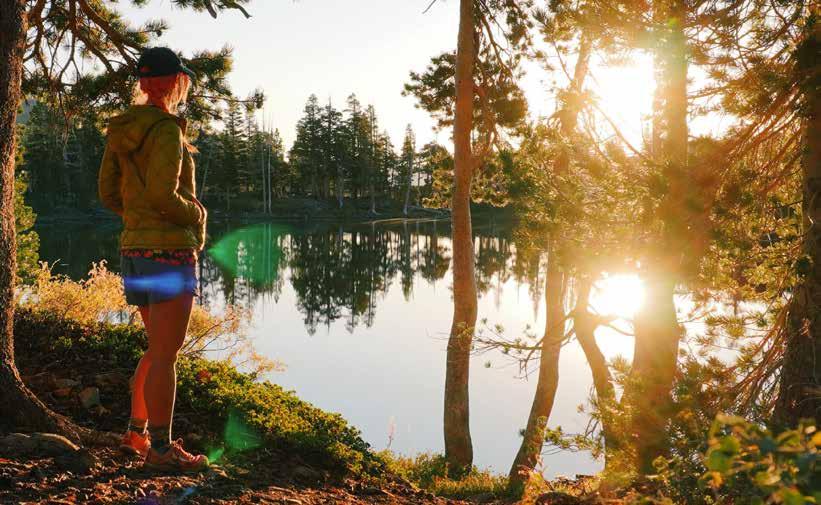
by Lauren Roerick
Itightened the straps on my backpack, took a deep breath of crisp alpine air, and snapped an obligatory selfie in front of the trailhead sign. The smile plastered on my face gave no indication of nerves, only joyful anticipation of what lay ahead. It had been a busy summer of work and I was looking forward to 10 days alone in the wilderness around Lake Tahoe. 170 miles of me, my backpack, and the trail was exactly what I needed to unwind and reconnect.
This calm, confident backpacker heading down the trail into the Desolation Wilderness is a far cry from the version that left on her first thru-hike of the Pacific Crest Trail only four years prior. That woman was all nerves and questions, with very little idea of just what she’d gotten herself into. But she was seeking adventure, independence, and wanted to see if she could hack it in the wilderness, alone.
Fast forward briefly to today, even after nearly 10,000 miles of backpacking across half
a dozen countries, I still get incredulous looks when I tell people that I, a woman, hike alone.
Sometimes the surprise is tinged with admiration, while other times it’s skepticism, masked as concern: “Aren’t you scared?” “Is that safe?” “Are you sure you shouldn’t bring someone along with you?”
Underneath my frustration at the implication of these questions, I get it. While the number of women I see on trail grows every year, we’re still in the minority, especially when backpacking alone. And that is something I’d love to help change.
The Tahoe Rim Trail, in all its rugged beauty, is an excellent choice for your first solo through hike, and one I can personally recommend.
To start, it’s the near perfect blend of challenge and comfort. It’s long enough to feel like a real adventure, but short enough to be manageable. It’s far enough into the wild to give you a sense that you’re away from civilization, but has enough resupply
points along the way to ease your nerves if something goes wrong.
Thanks to the incredible work of the Tahoe Rim Trail Association and its volunteers, the trail is well-maintained and clearly marked, making navigation straightforward. If you’re new to backcountry adventures or nervous about taking on a solo one, a well-marked trail that’s easy to follow mitigates a lot of nerves, and makes the trail more accessible. That feeling of safety makes time in the backcountry even more enjoyable.
I spent ten days circling Lake Tahoe, hiking through towering trees, across rocky ridgelines, and past alpine lakes that shimmered like glass. I met a few friendly faces along the way, but savored the solitude. I had space to breathe, think, and reconnect– both with nature and myself. There’s something transformative about carrying everything you need on your back and being totally self-reliant. You wake up every morning with nothing but what you brought out with you
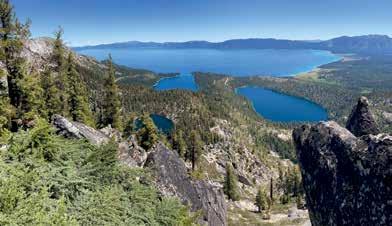
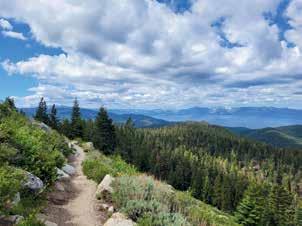
and only your own skills and instincts to get you to the next campsite. It’s not just about learning to survive in the great outdoors, but about learning to trust yourself.
On the trail, you make decisions constantly. Where to camp, how much water to carry, whether or not to climb the next pass before those dark clouds come in. You learn to listen to your body, to read the landscape, and to move forward even when the going gets tough.
That kind of self-reliance doesn’t stay out in the woods. It follows you home.
After every solo adventure, I’ve returned with a little more confidence in my voice, a little more clarity about what matters to me, and a little more calm in the face of uncertainty. I’ve learned how to be alone without being lonely, how to be scared without letting it stop me, and how to trust that I can handle what comes next—on trail or off.
For women especially, who are often taught to prioritize safety, caution, and control, stepping into the unknown and thriving in it can be profoundly empowering.
So yes, hiking the Tahoe Rim Trail was a beautiful outdoor experience, but it was also a reminder of just how capable I’ve become.
The annual TRTA photo contest is now open! Is your camera full of photos from your adventures on the TRT? Submit them to our contest by visiting tahoerimtrail.org/trta-photocontest/. We are accepting photos showcasing the TRT in all seasons and with all types of recreationists. The contest will remain open until September 30, 2025. Thirteen winning photos will be selected to be featured in our 2026 TRTA calendar. Winning photographers will receive a free calendar and a TRTA prize!
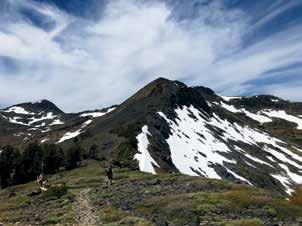
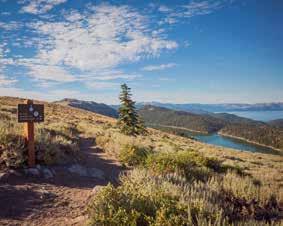
And if you give yourself the chance, you just might discover the same.
If you’re reading this and wondering if it’s safe, smart, or even possible to backpack alone as a woman, I hope this helps you find the courage to know that it is. And the Tahoe Rim Trail is a great place to start.
If you are inspired by Lauren’s story and eager to get into the backcountry yourself, don’t think that you also have to be alone in your preparation. Solitude in nature is special, but it can be difficult when planning a thru-hike, especially your first! We’ve worked diligently to become the best resource possible for recreators on the TRT: from our digital resources to a variety of maps and guides available at our store, and even backcountry skills courses like “Backpacking 101” and “Map and Compass.” In short: we’re here to help!
Finally, if you have a story like Lauren’s that you want to share, we are always looking to learn more about our trail users. Give us a call, shoot us an email, tag us on social media, or walk into the office. We’re grateful to connect, no matter the medium.
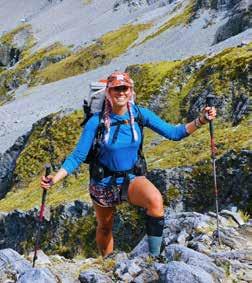
Lauren Roerick (@laurenroerick) is a longdistance backpacker who shares her solo adventures online to encourage more women to step into the outdoors with confidence. With nearly 10,000 miles hiked across long trails, she shares her experiences on trail through her video blogs on YouTube to demystify thruhiking and show that strength, resilience, and joy can be found on the trail—especially when you go it alone.
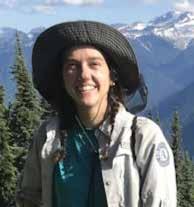
by Brooke Clayton Development Manager
Everyone lucky enough to visit or live in the Basin remembers the first time they saw Lake Tahoe. For me, it was at the tail end of a 14-hour drive, cresting Highway 50 at Spooner Summit and struggling to keep my jaw off the floor and my eyes on the road as sunset colors suddenly glinted off a picturesque, alpine lake tucked between granite peaks.
This memory makes it even more exciting to be part of the Tahoe Rim Trail Association’s upcoming project to evaluate if Spooner Summit could be the location for a multiuse highway crossing for both trail users and wildlife. Working with partners at the Nevada Department of Transportation and Pathways for Wildlife, the TRTA has a chance to set a new precedent for collaboration and innovation when it comes to recreational infrastructure.
“[This] hasn’t really been done around the world; there’s only a handful of examples,” explained Nova Simpson with the Nevada Department of Transportation (NDOT), her excitement palpable.
Most wildlife crossings are designed at odds with human infrastructure—a way for nature to traverse very unnatural landscapes. Yet Tahoe is unique for the fact that so many humans come here to connect with nature, to immerse themselves in the wild. At Spooner Summit, motorists are as likely to see a backpacker in the headlights as a deer. So, rather than imagine a straightforward wildlife crossing, the TRTA, NDOT, and Pathways see Spooner Summit as the perfect place to explore infrastructure that improves connectivity for both wildlife and people.
“This [project] could help provide some long-term guidance for others well around the world,” Simpson said.
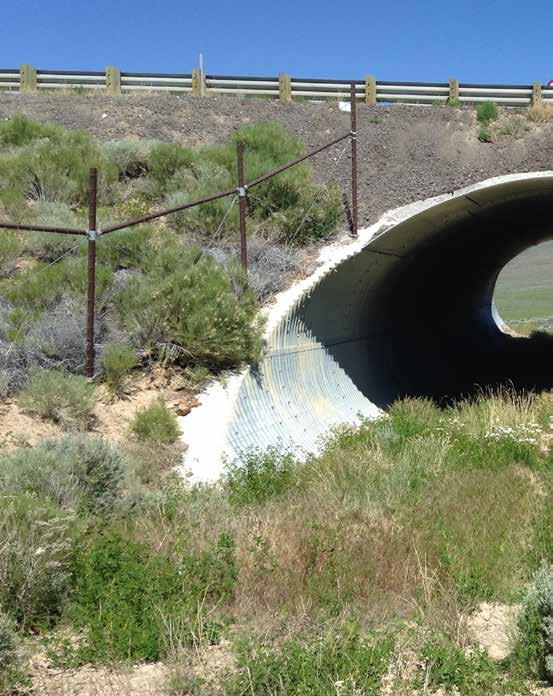
Simpson has worked with NDOT for over 12 years, but it is only in the past year that she’s taken on a new position that focuses on habitat connectivity as the Wildlife Crossing Program Manager. Growing data shows that Spooner Summit is a site of interest for animal-vehicle collisions in the state; data that helped the TRTA secure grant support from NDOT to complete a feasibility study over the next two summers for the highway crossing. As a lifelong local to the area,
Simpson also has a personal investment in the project at Spooner Summit.
“I grew up in this area and so I’ve seen the changes that have happened since the 80s to now,” she said. “I’ve seen how the growth in tourism as well as population growth in our own areas can be impactful.”
Simpson isn’t alone in her observations about the rapid influx of people to the Tahoe Basin. Visitation data mirrors or even outpaces some of the country’s National Parks. With more than 700,000 annual estimated users on the Tahoe Rim Trail alone, keeping pace with human impacts on the environment becomes
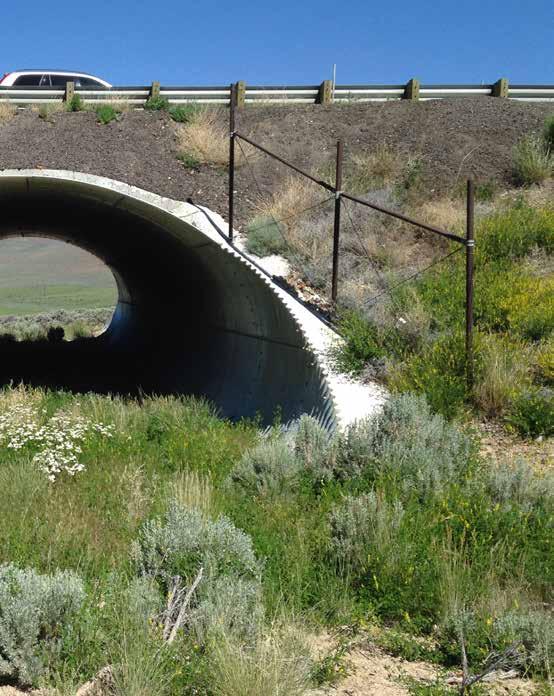
more difficult each year. And the more that people use the trail, the higher the chances grow of someone getting hurt crossing Highway 50.
But if the time ever came to implement this highway crossing, it would be years down the road. The project is the epitome of a ‘big picture’ idea, and for that reason, it’s also helpful to consider the history of Spooner Summit: how we arrived at this moment in time and what it says about the changing relationship between human infrastructure and nature, especially in a state ranked #4 for the fastest growing outdoor recreation economies in the country.
The Historical Marker Database explains that the summit was named after entrepreneur Michele E. Spooner, who acquired about 640 acres of land in 1860 to develop a sawmill, shingle mill, and hotel in the area. Decades of logging cemented Spooner Summit as one of the largest providers of lumber to Nevada’s Comstock lode—a silver deposit in the Virginia range that shaped the state’s history. What’s more, a sophisticated system of flumes and pipelines provided the water to run steam engines and support more than 30,000 people flooding into Nevada’s boom towns.
Road construction over Spooner Summit began in 1913 as part of the Lincoln Highway, according to the Nevada State Historic Preservation Office. In 1927 and 1928 the road became part of U.S. Highway 50, but it wasn’t until the 1950s that the stretch of highway over Spooner Summit was upgraded to its current two lanes of traffic each way.
As road development increased access to the Tahoe Basin, Nevada Governor James Scrughams made a 1923 proposal to set aside specific areas of Nevada’s public domain as “State Recreational Grounds and Game Refuges.” In 1934, the state dedicated Nevada’s first State Park and in 1969, Spooner Lake and Backcountry Park joined the list. A decade later, a group of passionate recreationists began to envision the Tahoe Rim Trail, and it was completed in 2001.
Since that time, our work at the Tahoe Rim Trail Association has steadily shifted from simply providing a recreational experience to protecting that experience, and Spooner Summit is no exception. In a trail use survey conducted by the TRTA in 2023, Mt. Rose to Spooner Summit was identified as the second most popular segment of the trail. Responses also indicated that the summit is a popular location for thru-hikers to begin and end their journey, with overnight parking available at both the North and South Trailheads. Among glowing comments about the beauty of Spooner and Marlette Lakes in this trail segment, one survey respondent wrote, “Crossing Highway 50 at Spooner Summit trailhead was one of the most terrifying things I have done.”
The history of this project site illustrates an interesting back-and-forth between
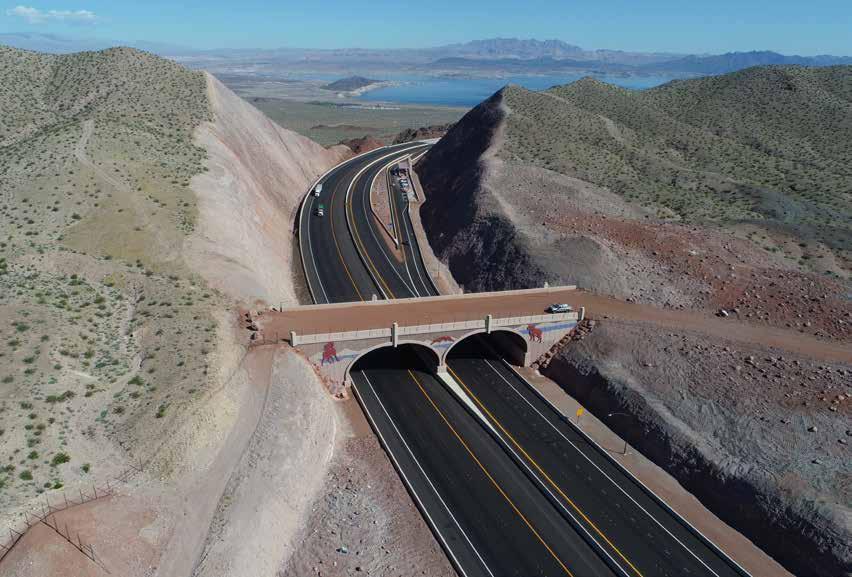
human ingenuity and development and our simultaneous, persistent desire to explore wild places. What makes the Highway 50 crossing so exciting is the potential to unite both of these historical forces and include wildlife in our infrastructure plans, when every other chapter in Spooner Summit’s 150+ year story has alienated Tahoe’s four-legged locals.
Simpson’s work embodies this generational shift toward considering natural habitat connectivity and wildlife safety while mitigating the risk for human safety on our roads. NDOT has formulated a prioritization criteria for highway crossings that considers not only wildlife vehicle collisions but also wildlife movement, big game habitat, special status species habitat, and ecological systems.
“We try to do the right thing as stewards of the land,” Simpson explained.
So, how do we involve a “user group” in our infrastructure plans that we can’t communicate with? The short answer is data. Wildlife collaring, roadkill observations, camera deployment, and tracking are the main tools
to learn how wildlife move across roadways. The first two elements of data collection are well underway, with a vast amount of collaring and roadkill data overlays currently in draft for publication by NDOT. What this unpublished data tells us is that the Spooner Summit corridor is a major thoroughfare for bears, but exactly where they cross Highway 50, and what other animals follow the same pattern, is still a major question.
Pathways for Wildlife is a research organization that will help the Tahoe Rim Trail Association find answers. To do so, they plan to deploy some 40 cameras in the area as well as collect wildlife tracking data: observing prints in the snow, mud, and dirt to learn more about what species are crossing Spooner Summit and where.
Tanya Diamond and Ahiga Snyder are a married couple that co-own Pathways: united in their tangible passion for wildlife connectivity, animal tracking, and education. Their data has been the catalyst for multimillion-dollar preservation projects
throughout California, and the two recently moved to Tahoe as part of a massive, community-wide effort to increase habitat connectivity in the Basin. They have 100+ cameras currently deployed in the South Shore and are already uncovering surprising and exciting insights about Tahoe’s wildlife: from the now-famous three-legged coyote thriving in South Lake to a surprisingly high concentration of deer for how infrequently they’re usually observed.
“It’s like living in a national park,” Diamond said about their move to Tahoe. She hopes to bring the same level of wildlife awareness and connectivity to Tahoe as you would see in Yellowstone or Yosemite.
Pathways camera data is particularly insightful because Snyder has mastered ‘at grade’ camera installations: a technique that provides a view of cars traveling on the road without having those vehicles trigger the motion sensors on the cameras. Wildlife trigger these ‘at grade’ cameras to begin filming, then Diamond and Snyder watch the
footage back with bated breath, hoping that their subject doesn’t become another victim of a wildlife-vehicle collision. Animals often avoid this fate by using existing infrastructure such as culverts, but in Tahoe, Pathways is discovering that those culverts are filled with water from snowmelt for most of the year, and animals will habitually go around them and use the road. It won’t be until this summer that we learn whether this is also the case at Spooner Summit.
Habitat connectivity is important for four main reasons, Diamond explained: food and water procurement, mating, juvenile dispersal, and genetic flow. She gave the example of the Santa Cruz mountain lion, a population facing endangerment simply because their habitat is isolated by human infrastructure. They are struggling to achieve genetic diversity, with evidence of inbreeding becoming more common.
“It’s kind of good there’s not a ton of mountain lions [in the Basin],” Diamond joked. This predator isn’t necessarily a species we’d encourage humans to get close to. “Here, there are people and wildlife on the trails together all the time, minutes apart, and they’re all getting along.”
Of course, if the crossing becomes a reality, it will still have to be designed with a defined separation that preserves pedestrian and wildlife safety by avoiding too close of contact.
Diamond explained that the opportunity to work with NDOT and the TRTA at Spooner Summit feels like a natural progression in her and Snyder’s goal to “work our way around the lake,” developing a clearer picture of how wildlife travels through the heavily touristed area and seeking innovative solutions to connect habitat across roadways.
For more information about becoming a Trail Ambassador and helping with these wildlife tracking efforts email our Engagement Coordinator, Colleen Hoffman at colleenh@tahoerimtrail.org.
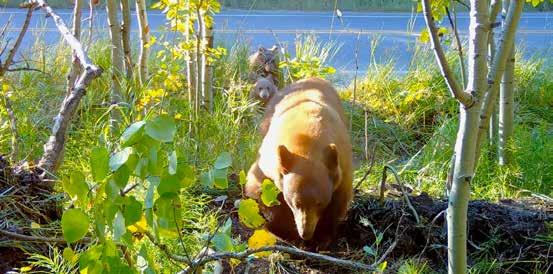
But they’re going to need some help.
You may be wondering at this point how our small trail organization will play a role in this very big project, and the answer is simple: our community. The answer is you.
Diamond developed a Rapid Assessment Method (RAM) as part of her Wildlife Ecology graduate thesis, which uses volunteer support to evaluate habitat transects for relevant wildlife data. Her and Snyder are both certified wildlife trackers and have a passion for sharing their knowledge with others. At Spooner Summit, the TRTA plans to connect Pathways with our incredible Trail Ambassador volunteers, who will be trained in wildlife tracking and dispatched to the project site throughout the summer to help with data collection.
As Snyder explained his approach to wildlife tracking, I felt the intimidating scale of this project slow down and zoom in on simple things that anyone can assist with. He explained that his connection to nature is
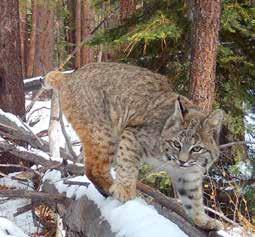
very deep seeded as a member of the Navajo tribe, how his desire to become a wildlife tracker was ignited the first time he saw the lumbering steps of a bear and felt desperate to see it again—to know where it was going and how it would get there. His tracking expertise is imbued with the conviction that an animal track is not static, rather, it’s a glimpse at a story that is constantly in motion.
Hearing him speak, I grew more and more invested in that story. I thought back to my first glimpse of Lake Tahoe at Spooner Summit, and how hard it was to anticipate the hold that this place would take over me. Like so many, I came to Tahoe for the beauty, but even more so, for the recreation. I could never know that in a few years, I wouldn’t just be hitting the slopes and the trails but working at the Tahoe Rim Trail Association to improve and preserve the Basin’s recreational experiences and deepen our human connection to the natural environment.
If you feel as compelled as I do to see this project come to fruition, the TRTA is always looking for more Trail Ambassadors to join our ranks and learn wildlife tracking techniques firsthand from Diamond and Snyder. Your observations could help the TRTA, Pathways for Wildlife, and NDOT make history. The more individuals join our cause, the more data we can collect; and the more data we can collect, the more compelling a case we can make to build one of the world’s first human and wildlife crossings at Spooner Summit.
“In terms of what we’re doing, connecting people and wildlife…this is so unique,” Diamond said at the end of our time together. “You are literally Trail Blazing.”
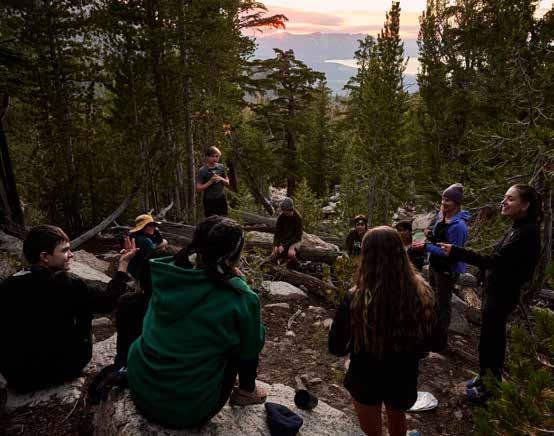
As I settle into my first year as TRTA’s new Youth Programs Manager, among the minutiae of learning new systems, logistics, and the administrative side of what it takes to run our Youth Backcountry Camps (YBCC), I also keep running into the overwhelming evidence of the large impact these programs have made on youth over nearly 20 years of backpacking with the TRTA. Whether it’s hearing insights from the diverse and incredible organizations we are lucky enough to partner with or the testimonies from teens about their experiences with us, it is clear that YBCC is a transformative program for young people. I have always strongly believed in the incredible positive change that can come from young people spending time outdoors and connecting to themselves, others, and nature. I’ve been privileged to witness this impact personally and professionally and am grateful to bring my many years of outdoor education experience to this unique program at the TRTA. Year after year, YBCC supports teens, instructors, and partners in creating fun and meaningful backcountry journeys,
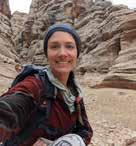
by Michelle Witte Youth Programs Manager
and I can’t wait to witness this experience during the 2025 season.
When invited to write this article, I was overjoyed at the potential to engage and learn from some alumni and decided to interview past YBCC participants about their time on the trail with us. I took some time to contact various partners to invite them to reach out to some teens they thought could offer perspective on how YBCC has impacted them. Something I love about our youth programs is that they serve a wide range of partners and young people from all over Tahoe and the wider region who hold a diversity of skill levels, cultures, perspectives, identities, and connections to nature. It was a joy to chat with the two teens I was able to interview, and I’m thrilled to share some snippets from those conversations with our readers to give deeper insight into what YBCC is like for our youth participants in their own words.
First, I interviewed Jack, a high school freshman from Sacramento who hit the trail with us in 2023. He joined YBCC through our partnership with El Parkis Youth Ministry. Jack had an engaging and articulate way of
speaking. He started the conversation off by saying he hadn’t had many chances to spend a lot of time in nature before his time on the Rim Trail with us and admitted he had been a little nervous about leaving technology behind. With most teens spending an average of seven hours a day on screens, it made sense that Jack was nervous to leave it all behind. The struggle to pull away from screens in today’s culture and fast paced life is something almost all teens face. This reality highlights the importance of time disconnected in nature for young minds. Several studies show how time away from screens spent in nature helps young people learn emotional regulation, increases their ability to focus, supports their physical well-being, and helps create a deep sense of belonging and appreciation for the outdoors. Time and time again science backs up what can seem like common sense to many, nature is the answer to many of the challenges we face today, especially for young developing minds. Greens over screens!
Jack shared with me how he wondered what would happen while being away from everything and sleeping outside. He added he was curious as to how the group would be preparing meals without access to a microwave or some of the other amenities that our kitchens provide. This gave me a profound gratitude for the ability of TRTA to fully outfit the youth on these trips with all the gear they need, from camp stoves, water filters, to quality backpacks and sleeping bags alongside instilling the skills and knowledge that empowers them to be able to use them properly.
Eventually, Jack said he learned how “stepping outside of your bubble makes you realize you can do something you never thought was possible before, and when I did it (backpacking) I realized how capable I was, and it was worth it in the end.”
Jack overcame his nerves about backpacking for the first time, carrying a heavy pack, and preparing meals in the wild. Four days on the trail supported him in his confidence of outdoor exploration and selfawareness. I asked if he learned anything about himself that he didn’t realize before going on the trip. “Before I went backpacking, people always said I was observant and noticed all sorts of things going on around me. I had never believed them or noticed that myself, but when I was on the trip, I finally saw that in myself, and noticed I was looking at everything big and small.”
He expanded that he was always taking in the big views of mountain peaks around him or noticing the smallest of sounds that the birds and squirrels made in the trees. Hearing about Jack’s ability to observe the world around him so keenly took me back to some of my early backpacking trips as a young naturalist working on my observation skills, and the early memories of slowing down to take in the world around me. These memories made a huge impact on my life at an early age, so I asked Jack if he had one lasting memory from his time on the trail.
He shared the feeling he had after climbing the hill past Big Meadow on the way to Round Lake and dropping into where the group would camp for their first two nights by the alpine waters. He said, “it was worth the effort and struggle of carrying a heavy backpack to sleep under the stars, away from distractions and connecting with great people.”
Another youth alumni that I was lucky enough to speak with about her experience was a three-time YBCC participant, Brooke. She joined YBCC through our collaboration with SOS Outreach. SOS Outreach is a longtime YBCC partner organization that fosters a sense of belonging in kids and teenagers through outdoor-based mentorship, primarily through their ski and snowboard mentorship programs in the winter. We are grateful to continue this reciprocal partnership by offering SOS kids and mentors two opportunities to hit the trail with us again this season. Through this mentorship program, participants gain personal and outdoor skills by progressing through the program for five or more years. Returning to YBCC multiple times through SOS has allowed Brooke to continue deepening her connection with nature and her understanding of responsible recreation, so that one day, she can be a mentor for others.
Brooke’s bright smile and excited disposition stood out immediately as the interview began. She had attended her first YBCC in 2023, which was also her first time ever backpacking. She was so inspired by her experience that she decided to join us again last year in 2024 for two separate camps.
A critical part of our YBCC curriculum is teaching the importance of the seven Leave No Trace principles, and with Brooke’s experience, I decided to see which parts of Leave No Trace she felt were the most important to remember while backpacking. Brooke intelligently responded, “They’re all
very important, but I think respecting wildlife is critical because we are visiting the animals’ natural habitat and it’s important to not bother them and respect their home.”
As the interview continued, I asked Brooke about some of her favorite memories and lessons from her various journeys with YBCC. She was excited to teach me that she learned you can use Sagebrush as deodorant, although she admitted she hasn’t tried it herself. She also fondly recalled memories of learning about other plants and trees. She smiled as she described swimming in the lakes and jumping off rocks as a huge highlight of her time in the backcountry.
As the conversation progressed, Brooke and I related on some of our favorite things about spending time in nature. Brooke reflected how, “backpacking and being in nature helps me clear my mind and get out of my head to just be present with my surroundings.” My number one reason for being an outdoorsy person is because it encourages me to be here, now. Brooke and I connected over discovering that sense of presence in the outdoors. She went on to share her favorite part of camping without a tent was “sleeping under the stars with a clear night sky that isn’t available in a lot of places.”
Backpacking trips have encouraged Brooke to spend more time in nature and be more aware of her impact on the environment. “We don’t want to ruin it!” she stated. I was happy to hear Brooke is planning to join her fourth YBCC trip with us again this summer!
It was impressive to hear Brooke and Jack tell me what they would say to another young
person who was backpacking via a YBCC trip for the first time and may feel nervous about the experience. Brooke shared, “I was nervous my first time too, but there are really good guides and mentors that will be there for you, and I made new friends that I’m still friends with that I met on the trip.”
Jack from El Parkis answered the same question with, “It’s okay to be nervous when you try something new, [YBCC] is worth it to be able to experience nature and be in the moment, you get to take in the beautiful flowers and trees all while being in great company.”
After speaking with both Jack and Brooke I felt awestruck at the power our Youth Backcountry Camps have to change lives. These two simple interviews reminded me of what several studies and common sense have shown for a long time, that creating a connection to the outdoors, especially at a young age, can have lasting impacts on people’s overall wellbeing, sense of belonging, and desire to care for the natural world. Being able to talk with these two teens is a great inspiration for me as I navigate my first season of leading the YBCC team. Jack’s favorite trail snacks might have been the sweet classic of dried mangoes, and Brooke’s the savory enjoyment of Goldfish; but despite their differences, they are both glowing representations of the impact that nature has on youth. It was clear to me that not only did YBCC help these teens learn and grow in their outdoor skills, but those four days in Tahoe’s backcountry also helped them develop as human beings.
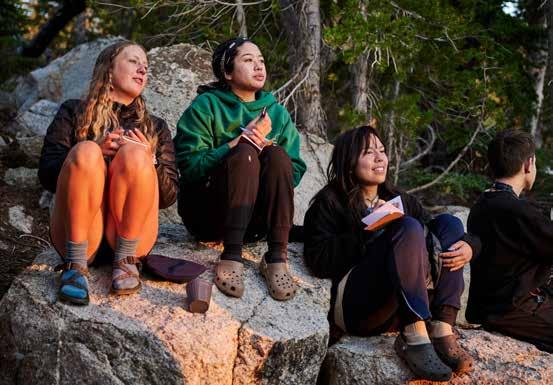
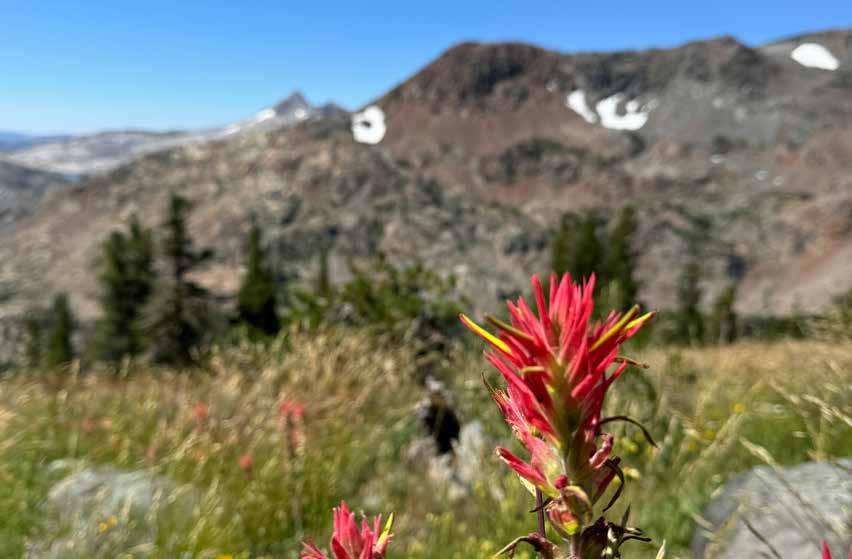
Individuals, families, and organizations can help to ensure the continuing legacy of the Tahoe Rim Trail by adopting their own vista or mile! Donors have the opportunity to be a steward of the trail by giving back to something they love—the trail and the Lake Tahoe Basin. Here are this season’s adopted vista and their special dedications. If you are interested in learning more about this program, email Veronica Palmer, veronicap@tahoerimtrail.org or visit tahoerimtrail.org/adopt-vista-adopt-mile/.
Lew Fellows Vista (Watson lake)
Lew Fellows spent his childhood exploring the mountains of the North Shore. He was raised by Marge Fellows (original postmaster of Carnelian Bay) and Ray Fellows (owner of the Trading Post Resort, Carnelian Bay Grocery, and Carnelian Bay Miniature Golf). Watson Lake was Lew’s favorite destination during the many happy hours he spent wandering and making memories in the woods behind his home. In the early 50s, Lew was a ski sensation in North Tahoe. He competed at the highest levels and even tried out for the 1956 Olympics.
Lew spent his adult life encouraging and coaching young skiers through his involvement with Auburn Ski Club and Sierra College. Lew was a true son of Tahoe; wherever his travels took him, he always returned to the Sierra Nevada and Lake Tahoe.

Pass Vista
What did Dave White love? He loved Tahoe. He loved Desolation Wilderness. He loved backpacking, stargazing, hiking and camping at Dick’s Lake. So, when his family and friends were looking for a way to remember his life and honor his interests, the Tahoe Rim Trail immediately came to mind. At the vista we are adopting in his memory, hikers can see a large part of the wilderness that played an important role in his life. Sharing this place and encouraging others to enjoy the unspoiled outdoors that this trail traverses is our tribute to his life and a way to contribute to keeping it accessible going forward.
Dave, looking into Desolation Wilderness from Barker Pass, and checking the snowpack as he plans his next hike.

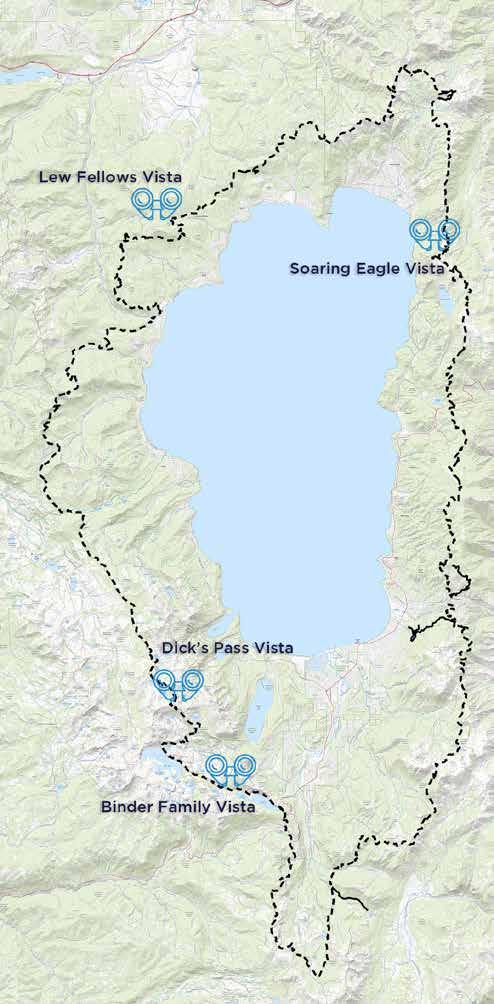
Incline resident, Durian Pingree, was known for his ever present good humor and welcoming arms. He was also an athlete, scholar, musician, dog lover, and a super host to friends and neighbors.
He was a gift to us all. We lost him too soon to the horrible disease of Parkinson’s.
Soar above it all, Dur, and we’ll wave to you and remember.

My mother, Laura Binder, passed away unexpectedly this January, leaving our family heartbroken in our grief. As we searched for a way to honor her memory and create a lasting legacy that would help us heal from our deep loss, we turned to the Adopt-A-Vista program at the TRTA. Our family has enjoyed membership with the TRTA for nearly a decade, and the trail has been a special place for us to volunteer, recreate, and find peace in the beauty of Lake Tahoe and the surrounding landscape. By honoring my mother with a vista dedicated to her memory, we will support a cause she held dear and create a space to visit again and again where we can find peace and meaning as we reflect on our loss and the life and love we shared with my mom.
—Chris Binder
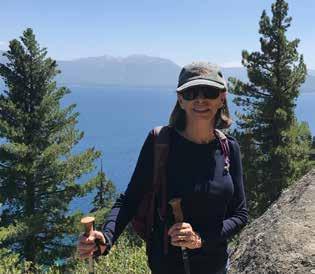
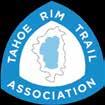
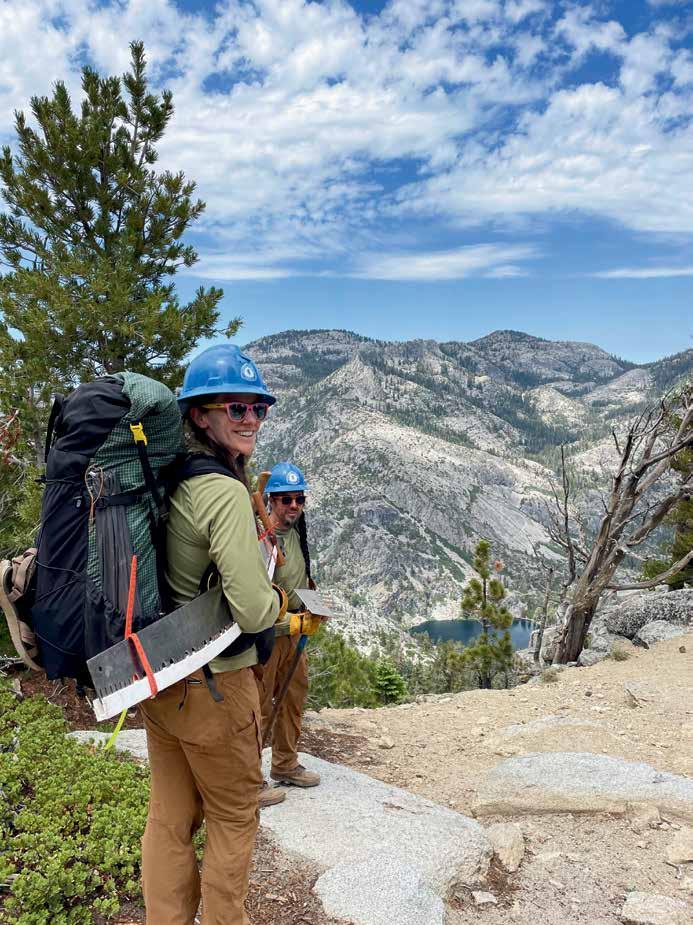
NATIONAL TRAILS DAY
WORKDAY AND AFTER PARTY
JUNE 7 9:00-4:00 PM
Join us at Big Meadow to kick off the trail season with the completion of the Big Meadow Highway crossing. After toast your hard work at our afterparty at Divided Sky in Meyers.
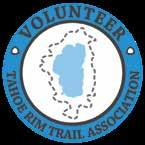
Our sincere thanks to the incredible volunteers out on the trail! Sign up to be a volunteer at tahoerimtrail.org/volunteer.
Don Bailey
Donna Maher
Doug Johnson
Jackie Ferek
James Large
Jamie Nowitzky
Jared Coons
Jessica Drizin
Jim Crompton
John Clausen
John McCall
John McKenna
Karl Picking
Keith Sanders
Larry Davis
Marilyn Sanders
Mark Wynne-Willson
Michelle Edmonson
Mike Kuckenmeister
Nicole Kryda
Patrick Pevey
Paul Sinnott
Phil Brisack
Shannon Foley
Stephen Brown
Ita Abarzua-Kostan
Jamie Goodspeed
Nowitzky
Jennifer Coon
Jim McNamara
Jim Mrazek
Jo Ann Cobb
John Ferguson
Joseph Salonga
Karin Regnstrom
Kate Huckbody
Kirby Booth
LaTrenda Easton
Laura Van Antwerp
Laurie Buffington
Loretta Low
Mary Davidson
Matthew Taylor
Maureen Welsh
Melissa Johnson
Michael Kreisel
Michelle Beaupied
Raelynn Noel
Rita Stoufflet
Sharell Katibah
Steven Cochrane
Tom Fullerton
Tricia Tong
Aletha Nelligan
Carol Nageotte
Claudia Hansen
Dan Gonzales
Donna Ting
Douglas Dilts
Ellen Goldsmith
Jennifer Coon
Julia Suman
Katie Gates
Lawrence Souza
Lisa Dossey
Michael Groff
Rebecca Creemen
The Tahoe Rim Trail Association thrives on the dedication of its volunteers, and few embody that spirit as wholeheartedly as Rebecca Cremeen. As a devoted board member and trail ambassador, Rebecca’s passion for the outdoors and her commitment to preserving the Tahoe Rim Trail shine through in everything she does. Her contributions are a testament to the crucial role that volunteers play in maintaining and enhancing the trail system, ensuring that the natural beauty of the Tahoe Basin remains accessible for generations to come.
Rebecca’s journey with the TRTA began as a curious newcomer to Tahoe. Drawn to the interpretive signs at the trailheads, she quickly took note of the TRTA’s involvement. “I’m a bit of a nerd when it comes to interpretive signage,” she says with a smile. “Seeing the Rim Trail logo everywhere made me realize that there was a dedicated organization behind these beautiful trails.” Working at the Tahoe Regional Planning Agency, located just next door to the TRTA office, gave her a firsthand glimpse of the tireless efforts of the trail association.
It wasn’t long before Rebecca took her curiosity a step further. Inspired by the TRTA’s impact on trail maintenance and community education, she embraced her first volunteer role as a trail ambassador. Standing at popular trailheads like Big Meadow, Rebecca welcomed hikers, provided guidance, and educated visitors on Leave No Trace principles. The experience deepened her appreciation for the trail community and the vital role volunteers play in preserving the area’s natural beauty.
Rebecca’s dedication soon led her to a position on the TRTA Board of Directors. She was invited to join the board by a colleague, she was eager to contribute her skills to ensure the association’s long-term success.
“Joining the board allowed me to support the organization on a larger scale,” she explains. “From fundraising and community events to helping staff feel supported, it’s been incredibly rewarding to play a part in the sustainability of the TRTA.”
As a board member, Rebecca champions initiatives that empower both staff, volunteers, and trail users. She enjoys playing a part in ensuring that the trails receive the care and resources they need.
Among Rebecca’s most cherished experiences as a volunteer are the connections she’s made with fellow nature enthusiasts. She recalls one especially memorable moment when a group of Boy Scouts completed their first-ever backpacking trip on the Tahoe Rim Trail.
“They were so proud of what they accomplished,” Rebecca shares. “We spread out the map, retracing their route, and celebrated their journey. Moments like that remind me why this work is so important — it’s about creating experiences and fostering a love of nature.”
Rebecca’s belief in the power of volunteerism continues to be fuel for her “why” in giving back. The work of the Tahoe Rim Trail has always been important however with reduced federal funding and increased visitation to natural spaces, the need for dedicated volunteers has never been greater.
“The timing is critical,” she says. “Without organizations like the TRTA, we would see far more trail degradation. Volunteers are the backbone of trail maintenance and education efforts. They’re the reason people can enjoy these pristine spaces.”
She encourages anyone with a passion for the outdoors to find a role that resonates with them. Whether it’s hands-on trail work, acting as a trail ambassador, guiding, or contributing to fundraising and events, there’s a place for everyone in the TRTA community.
“Even small acts of service can have a lasting impact,” Rebecca notes. “And the rewards are countless — the friendships you build, the memories you create, and the pride in knowing you’re helping to preserve something truly special.”
Inspired by Rebecca’s story? The TRTA welcomes all who wish to give back to the trails. Consider joining as a volunteer, attending a community event, or supporting the association through membership and donations. Together, we can ensure that the Tahoe Rim Trail remains a treasured resource for all who seek adventure and solace in the great outdoors.
Visit www.tahoerimtrail.org for more information on how to get involved.
Thank you, Rebecca, for your unwavering dedication and inspiring
leadership. You truly are a TrailBlazer.
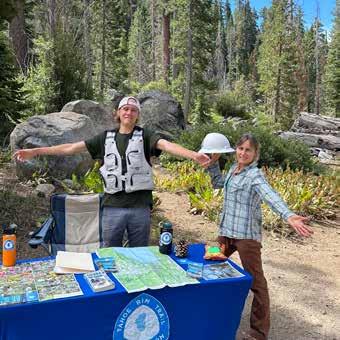
Since the first 165 Club Member earned their place at #1 in 1998, this program has stood as a pillar at the TRTA that celebrates what truly makes our trail special: the people out there enjoying it. The 165 Mile Club has a way of bringing our supporters stories to the forefront: from Teresa
Kyle Vonderwerth #3233 and Pepper (Dog) #153
River Dawson
Lisa Schulz
Tammy Sieminowski
Torsten Schulz
Ashley Boden and Rylee (Dog)
Warren Heinrich
Susan Trounday Banks
Nicole Kelling
Ryan Racca
Mary Morgan Keenan
Mary Ellen Walker
Bridget Ulrich
Mei “the mudworm” Xi and Little One & Mango (Dogs)
William Sherman
Chris “Blue’s Clues” Perez
Vern Howard
Kalyn “Pika” MacDonald
Edward McCarroll and Mike (Dog)
Caroline Marie Bik
Bruce Riddle
Junhie Oh
Mike “DocWats” Watkins
Joe Fitzpatrick
Brad Findlay
Kelsey Bollman
Justin Tann
Rachel Kimmerle
Dean Bosche
John S. Wang
Lars Schoenbrunn
Ginny Silva
Mike Bencze (G.O.A.T)
Katherine J. Rosé
Leanne “Peanut” Alexander
Mallory “Bullseye” Weston
Leslie “Bones” Boyd
Emily McCool “Ducky” Cobb
Wesley Finley
Roberta Percy
Sharon Brady Silva
John Weingart
David Christopher
Naʻaualiʻi Adler

Sayo Costantino
Christine Cuk
Madeleine Augustsson
Todd Brandt
Misty Klement
Brooke Mechels and Lotus (Dog) & Naxlé (Cat)
Terry Anderson
Betty Czyz
Brent “da Vinci” Warnken
LeeAnna Bristol
Karen Willemsen
Krystal North
LaTrenda Easton
Astrid Klocke
Darrell Armuth
Doak Jones
Durs Koenig
Eric Judge
Kevin Mckay
Kurt Heckmann
Patsy Young
Steven Tuttle
Chloe Harrison
Chris Terril
Douglas Houston
Emma Peat
Grace Koenigsaecker
Marcus Beyerle
Patty Carlson
Stacie Griffin
Marianne Murphy
Karen Ernst
Terry Murphy
Christine Kessler
Bahar “Happy Hiker” Patel
John Price
Lynn Price
Jennifer Lyn Coon
Jen Bailey
Kathleen Stabler
Renee Xue
Dawn Theirl
Jason Sugimure
Lance Olson
Andrea Steinbach
Heather Benson
Tyler Neff
Vincent—who overcame a pulmonary embolism during her first thru-hike attempt to come back and finish the trail in 2024—to John Best, who dedicated his hike to one of the TRT’s original trail builders: Art Kerber. Some took years to finally complete every section of the TRT, like Harvey Katz, who had only had one segment left since 2018 and finally knocked it off his list in 2024. Others pushed the limits of “fastpacking,” like Ari Backholm, who completed the trail in 2 days and 20 hours. Yet regardless of the speed of their journey, the weight of their pack, or the level of experience under their belt, every member of the 165 Mile Club is brought together by their persistence and passion. Thank you to each and every individual in this list for reminding us all at the TRTA why we work so hard to make the TRT “a trail like no other.” If you are interested in joining the 165 Mile Club, visit our website at tahoerimtrail.org/165-mile-club/
Lisa Connally
Madeline Lutz
Richard Jacobus
Myles Guletz
Jacob Guletz
Ashley Guletz
Fletcher Guletz
Michael Hewitt
Rachel Erickson
Daniel Rafael Thaler
Mike Runnals
Cristine Wright
Nicholas Arteberry
Adam Yoxtheimer
Stephen Chapman
Michael Gold
Alan Gianini
Aaron Braun
Jim LaTorre
Joan Rusche
Deb “Mona Lisa” Coleman
Scott Decker
Ray Murphy
Terri Rosen
Jeff Hawkins
Sue Kelly
Noelani Reinker
Laura Lenseigne
Harper Wicker Lenseigne
Jamie “Drumstix” Goodspeed
Nowitzky
Dave “Yacht Rock” Nowitzky
Vide “Jet Boil” Nowitzky (Dog)
Ashley McRae
Aaron Tenner
Nathan Dettlebach
Bjorn Thaler
Dana Low
Virginia Ross
LouAnn Jessup
Ryan Williamson
Mike Miller
Corey T. Hofheinz
Jim Hall
Teresa Hall and Skye (Dog)
Mike Warrington
Tracy Hood
Erin Dixon
Michelle Herschbach
Jenny Swall
Bill Rowe
Jordan Fricke
Harvey A Katz and Bonanza (Dog)
Cody Wade
Kathy Donovan
Michelle Duke
John F. Best
Cassie Kays
Sarah Hodge
Benjamin Bentler
Ari Backholm
Allison Foster
David Whitehair
Skyler Mena
Claudia Velasco
“Chicago” Aaron Borowski
Alexandra Hedgpeth
Jason Weaver
Tonnis Wildeboer
Mike Miller
Lisa Fisbeck
Joey Grisafe
Cassidy Harless
Deanna McConnell
Keith McConnell
Douglas Higgs
David B Reneau
Verne Deason
Todd Raubenolt
Greg Schumaker
Derek Gray
Jason Hodge
Elizabeth Ashman
Steve Lico
Sandra “Drag Queen” Bergeron
Bev “Moonshine” Blach
Sharon “Caboose” DeJong
Lisa “Tumblina” Olson
Bridjet “Spark Plug” Orr
Aimee “Strix” Reiss
Courtney Polidori
Justin Thomsen
Nathan Clinger
Andrew Clinger
David Gerberding
Janey Balvin Rzeplinski and Walter (Dog)
Kimberly Richards
Richard Brightman
James Dwyer
Paul Andrews
Teresa Vincent
Clint Baxter
Lori Bard
Kim Stephenson
Jesse Gardner
Kevin Callan
Michael Buffington
Donald Denton Anderson
Josh Gustafson
Ilyce Shugall
Dennis M Robinson
Daniel R Hunte
Lauren Roerick
Joe Ceirante
Jeff Dugger
Rita Stoufflet
Scott McKenzie
Michael Liner
Danny Minkow
Linda Minkow
Kristina Weber and Tank & Echo (Dogs)
LongJohn
Rodney Deaton
Mary Deaton
Andi Honer
Beth Vollmer
John Mercurio
Stan Reese
Bob Campagna
Maeja Post
Janice Perkins
Spencer “Gumby” Ruchti
Kate “Badger” Brouns
Cameron M. Gulden
Gina Wyneken
Meagan Hanbury
Stephanie Wade and Artemis (Dog)
Amy Shing #3459
The TRTA is fortunate to receive grant funding from a range of private and public sources, both local and national. Thank you to each one of these grantors for helping us “inspire stewards and preserve the trail.” For more information contact Brooke at brookec@tahoerimtrail.org.
American Trails
Athletic Brewing Co
Caesars Foundation
California Alpine Club Foundation
California Tahoe Conservancy
City of South Lake Tahoe
Jack Van Sickle Foundation
John Ben Snow Foundation & Memorial Trust
John W. Altman Charitable Foundation
Joseph and Vera Long Foundation
Lake Tahoe Visitors Authority
Lana Vento Charitable Trust
Martis Camp Foundation
Nancy Eccles and Homer M.
Hayward Family Foundation
National Forest Foundation
Nevada All-State Trail Riders

Nevada Department of Transportation
Nevada Division of Outdoor Recreation
NV Energy
Nevada State Parks
OK To Be Different Foundation
Pacific Crest Trail Association
Parasol Tahoe Community Foundation
Tahoe Fund
Tahoe Mountain Resorts Foundation
Tahoe Truckee Community Foundation
The Latrobe Fund
Heavenly Mountain Resort Epic Promise Foundation
William H. Moffat Jr. Foundation
May 31–June 1: Wilderness First Aid Course
June 7: National Trails Day: trailwork at Big Meadow
June 8: Annual Meeting and Awards, Valhalla Tahoe
June 17: Pack, Prepare, Hike: Gear for the TRT (Trail Talk), South Lake Brewing Company
June 27–28: Backpacking 101 Course
July: Spooner Summit workdays
July 30: Earth Underfoot: Exploring TRT’s Geology, South of North Barn
August: Tahoe Meadows workdays
August 2–16: Guided Thru Hike of the Tahoe Rim Trail
August 14: Guided Exploration Series with TINS: Galena Falls Wildflower Hike, Galena Falls
August 16–30: Guided Thru Hike of the Tahoe Rim Trail
August 22: Wander Women: Hiking the TRT, Inspiration Point
September: Barker Pass workdays
September 16: Guided Exploration Series: Birds, Botany and Beavers, Spooner Lake
October 21: Guided Exploration Series: Fall Changes, Page Meadows
Visit tahoerimtrail.org for more about guided hikes and programs.
TRTA Business Members are essential partners that help us fulfill our mission. These partners help ensure the Tahoe Rim Trail remains just as phenomenal in the future as it is today and help us inspire the next generation of environmental stewards. For more information on becoming a Business Member, contact Veronica at veronicap@tahoerimtrail.org.













We are seeking $15,000 to match a grant from the Tahoe Fund this summer. The funds will support six weeks of trail maintenance from the American Conservation Experience (ACE).
Invest in the trail you love today
